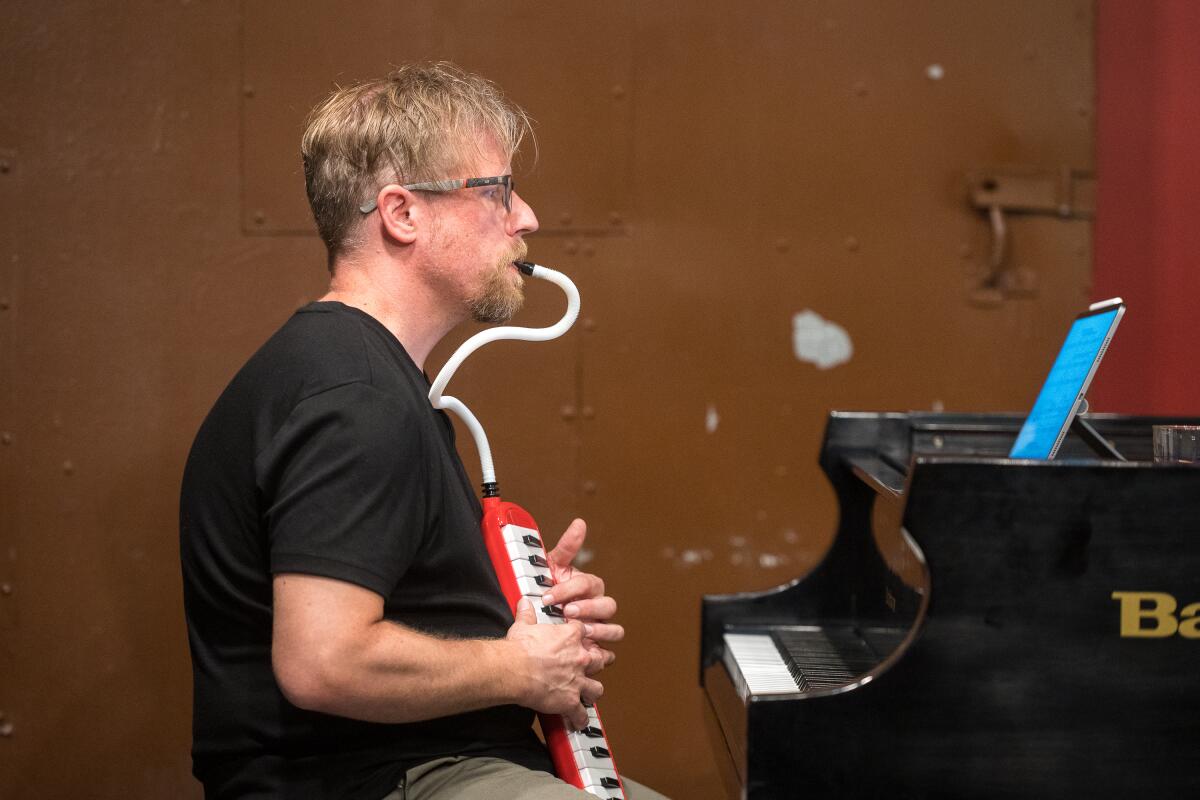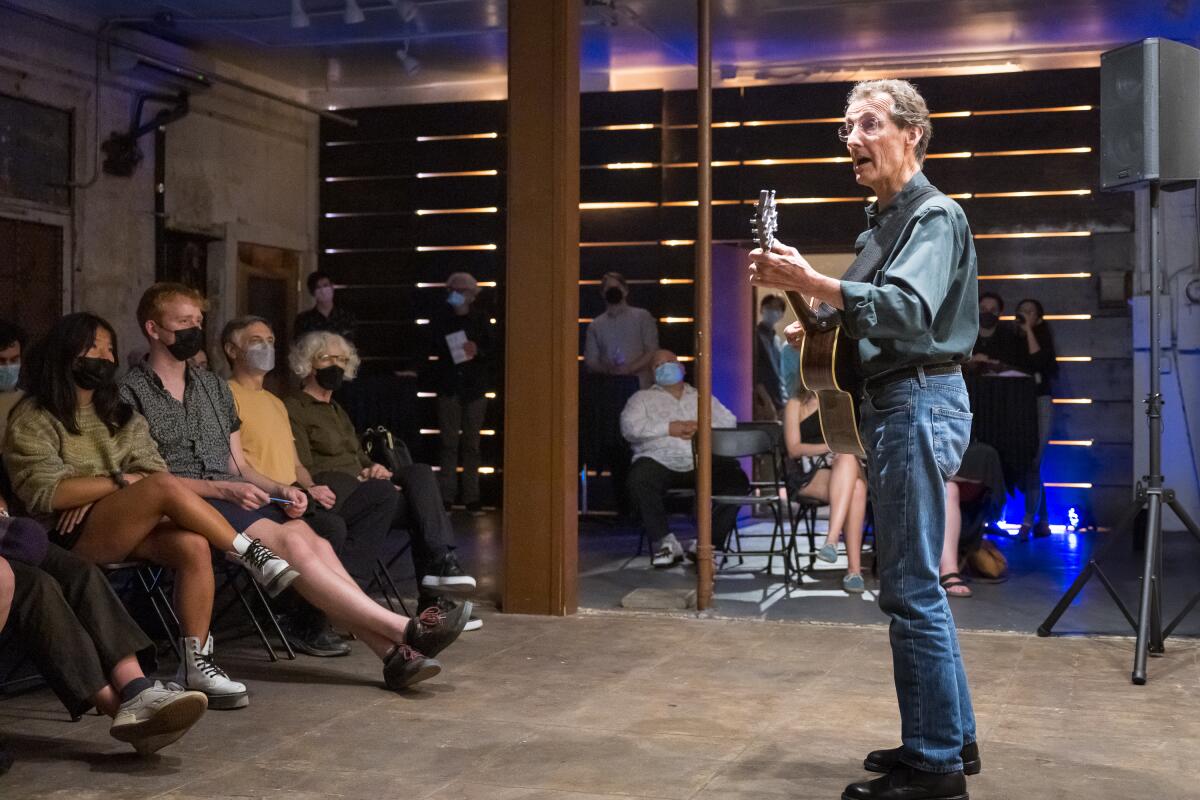Commentary: Why new music has come roaring back in L.A.

The Wikipedia page for the Los Angeles Philharmonic has a list of the orchestra’s world premieres. Only a single one is noted for the 2021-22 season, Julia Adolphe’s “Woven Loom, Silver Spindle” in December. Is anyone up for the task of updating that?
Since April Fools’ Day alone, the L.A. Phil has presented, by my casual count, works by 70 living composers, most of them premieres. Every program by the full orchestra or members of the L.A. Phil has contained at least one new piece. In L.A. County (and throwing in, for good measure, the Ojai Festival, which attracts a largely L.A. audience), the number of works played during those 12 weeks by living composers may well approach 200.
Try to find an ensemble, from the staunchest to the funkiest, that hasn’t gotten into the act. To pick a grand and traditional institution, Los Angeles Opera displays a 3-1 score sheet — two operas and one orchestral song cycle by living composers and an opera by Verdi (go back two weeks to March 19 and add a third new opera).
This is an exceptional phenomenon. Thirty years ago, we might have hailed as rare and consequential any dozen weeks in which music by a mere handful of living composers was programmed as the regular course of a classical music season. When André Previn became music director of the L.A. Phil in 1985, he made a point of inviting critics to come to the rehearsals any time he was conducting a new piece, that being such an uncommon big deal. Now it is such business as usual that who has time to go to rehearsals?
New York, London, Berlin, Paris and Amsterdam happen to be historically vibrant centers of new music. They are presently home to more major composers than L.A. and feature impressive quantities of new music. They are capable of producing elaborate festivals of new music and accommodate prominent new music ensembles on a greater scale than we do.
But new music hasn’t in those cities, as here, penetrated every pore of the classical music scene. When the Berlin Philharmonic or the Concertgebouw Orchestra in Amsterdam does a new piece, it’s almost like 1985 again in L.A.
New music has become a way of life, be it, and in no particular order, at Walt Disney Concert Hall, Broad Stage, Zipper Hall, the Hollywood Bowl, REDCAT, Royce Hall, the Ford, the Wende Museum, the Wallis, First Presbyterian Church in Santa Monica, 2220 Arts + Archives, the Dorothy Chandler Pavilion, Hauser & Wirth and Descanso Gardens. New music pops up in small galleries in alleyways and at the Mount Wilson Observatory. The Monday Evening Concerts, the longest-running new music series in America and possibly anywhere, began in 1939 as Evenings on the Roof in a small studio atop an unpretentious Silver Lake home, where, before long, it attracted the likes of Schoenberg and Stravinsky.
The third weekend in June was a busy time for performances, and the operatic end-of-season options were new music. L.A. Opera presented Kevin Puts’ “The Brightness of Light,” while Long Beach Opera turned to Anthony Davis’ “The Central Park Five,” both from 2019. At the same time, Broad Stage gave the world premiere of Fahad Siadat’s “The Conference of the Birds,” a ritualistic staging of his a cappella score based on a parable by the 12th century Sufi poet Attar.
Because of time conflicts, I could attend only the dress rehearsal. Elegantly staged and choreographed by André Megerdichian, “Birds” remains apart from much contemporary work today, being not about the possession of identity but losing it to become one with humanity. For Siadat, who conducted a luminous ensemble of singers, diversity is celebrated by the merging of character-driven individual voices into a verdant, copious whole.
The weekend also included two events that focused on two outsider artist icons of new music, Harry Partch and Julius Eastman. “Outsider” in this case could not be a more apt description: Partch rode rails in the 1930s and Eastman was thrown out of his apartment and onto the New York streets in the 1980s.
While unable to squeeze the annual REDCAT appearance of the Partch ensemble or the ensemble Wild Up’s sunrise-to-sunset marathon performance of Eastman’s “Buddha” at 2220 Arts + Archives, also that weekend, I can report on illuminating new recordings from both ensembles. Guitarist John Schneider, founder of the Partch ensemble, has produced on MicroFest Records a book and CD package documenting a lecture and recital the composer gave in 1942 at the East School of Music. For the first time we can now hear Partch sing and play “Barstow: Eight Hitchhikers’ Inscriptions” on his oddly tuned “adapted guitar” the year after he jotted them down at homeless encampments. Wild Up, meanwhile, has just released “Joy Boy,” the exuberant second volume of its unmissable ongoing series of Eastman recordings.

Attendees gather for a Tuesdays @ Monk Space event.
Then came Tuesdays @ Monk Space, at the Koreatown creative site, that offered an insiders’ gathering of local new music ensembles and performer-composers. Eleven 20-minute sets were simultaneously performed in Monk Space’s two wonderfully resonant spaces.
Is there a laid-back L.A. sound? Yes. Is there an aggressive, in-your-face L.A. sound? Yes. Might there be a place for newly arranged Bach in all this? But of course.
This Q&A, with always the same A, could go on for a considerable while. If you hope to put your finger on what makes L.A. a center of new music, you will only look foolish frenetically waving your hand in the air.
The real answer was at Monk Space June 21 at a new music fundraiser for Brightwork, which presents the monthly Tuesdays @ Monk Space programs. With constant performances in the two galleries and wine and talk in the adjoining courtyard, nothing more nor less was asked of new music than that it be a congenial way of life.
This could be the Brightwork Ensemble dazzling with Zodiac-inspired pieces by Vera Ivanova, Adam Borecki and Vicki Ray. At a different extreme, the longtime, invaluable L.A. new music record label Cold Blue Music presented pianist Ron Squibbs playing Peter Garland’s quiet and content “Three Dawns,” which the label recently recorded.

Much was striking. The outstanding Eclipse Quartet offered Sarah Gibson’s expansive “All Ashore.” As part of the piano duo Hocket, with Thomas Kotcheff, Gibson knocked out a gleefully insistent duet by Tristan Perich. I was in the wrong room to hear Isaac Schankler perform Alvin Lucier’s “Music for Accordion With Slow Sweep Pure Wave Oscillators” but did catch Scott Worthington make magic with his solo acoustic bass and electronics and a bit of Schneider’s own characterful, yet true to Partch, way with Partch’s “Barstow.”
In the end, the concert was a new music party to which everyone, performers and audience, was invited. The music was the bumping into and talking to different people whom you may or may not have known. You could let your interests and curiosity guide you.
Is hospitality, maybe, the real secret for our new music success story? I’d like to think that an environment of acceptance has something to do with it. This was my first time back at T@MS in more than two years, and the sensation of walking into Monk Space was that of the mind opening.
More to Read
The biggest entertainment stories
Get our big stories about Hollywood, film, television, music, arts, culture and more right in your inbox as soon as they publish.
You may occasionally receive promotional content from the Los Angeles Times.











